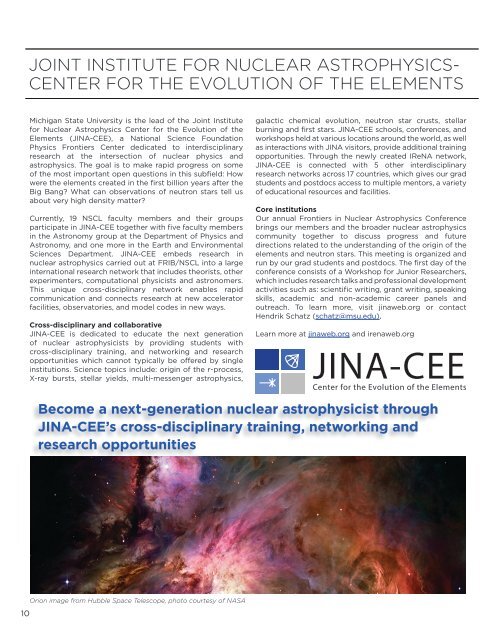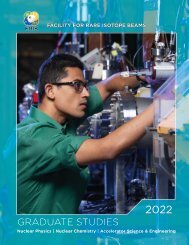2021FRIB/NSCL Graduate Brochure
Create successful ePaper yourself
Turn your PDF publications into a flip-book with our unique Google optimized e-Paper software.
JOINT INSTITUTE FOR NUCLEAR ASTROPHYSICS-<br />
CENTER FOR THE EVOLUTION OF THE ELEMENTS<br />
Michigan State University is the lead of the Joint Institute<br />
for Nuclear Astrophysics Center for the Evolution of the<br />
Elements (JINA-CEE), a National Science Foundation<br />
Physics Frontiers Center dedicated to interdisciplinary<br />
research at the intersection of nuclear physics and<br />
astrophysics. The goal is to make rapid progress on some<br />
of the most important open questions in this subfield: How<br />
were the elements created in the first billion years after the<br />
Big Bang? What can observations of neutron stars tell us<br />
about very high density matter?<br />
Currently, 19 <strong>NSCL</strong> faculty members and their groups<br />
participate in JINA-CEE together with five faculty members<br />
in the Astronomy group at the Department of Physics and<br />
Astronomy, and one more in the Earth and Environmental<br />
Sciences Department. JINA-CEE embeds research in<br />
nuclear astrophysics carried out at FRIB/<strong>NSCL</strong> into a large<br />
international research network that includes theorists, other<br />
experimenters, computational physicists and astronomers.<br />
This unique cross-disciplinary network enables rapid<br />
communication and connects research at new accelerator<br />
facilities, observatories, and model codes in new ways.<br />
Cross-disciplinary and collaborative<br />
JINA-CEE is dedicated to educate the next generation<br />
of nuclear astrophysicists by providing students with<br />
cross-disciplinary training, and networking and research<br />
opportunities which cannot typically be offered by single<br />
institutions. Science topics include: origin of the r-process,<br />
X-ray bursts, stellar yields, multi-messenger astrophysics,<br />
galactic chemical evolution, neutron star crusts, stellar<br />
burning and first stars. JINA-CEE schools, conferences, and<br />
workshops held at various locations around the world, as well<br />
as interactions with JINA visitors, provide additional training<br />
opportunities. Through the newly created IReNA network,<br />
JINA-CEE is connected with 5 other interdisciplinary<br />
research networks across 17 countries, which gives our grad<br />
students and postdocs access to multiple mentors, a variety<br />
of educational resources and facilities.<br />
Core institutions<br />
Our annual Frontiers in Nuclear Astrophysics Conference<br />
brings our members and the broader nuclear astrophysics<br />
community together to discuss progress and future<br />
directions related to the understanding of the origin of the<br />
elements and neutron stars. This meeting is organized and<br />
run by our grad students and postdocs. The first day of the<br />
conference consists of a Workshop for Junior Researchers,<br />
which includes research talks and professional development<br />
activities such as: scientific writing, grant writing, speaking<br />
skills, academic and non-academic career panels and<br />
outreach. To learn more, visit jinaweb.org or contact<br />
Hendrik Schatz (schatz@msu.edu).<br />
Learn more at jinaweb.org and irenaweb.org<br />
JINA-CEE<br />
Center for the Evolution of the Elements<br />
Become a next-generation nuclear astrophysicist through<br />
JINA-CEE’s cross-disciplinary training, networking and<br />
research opportunities<br />
10<br />
Orion image from Hubble Space Telescope, photo courtesy of NASA






